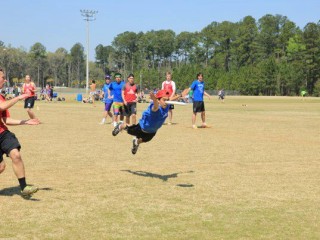
When I used to wake up at 4:00am to drive two hours through middle of nowhere Maine to play in an unsanctioned tournament on a torn up field, the furthest thing in my mind was my team’s purchasing power. Maybe it was the subfreezing temperatures, but I just wasn’t thinking about the money my teammates and I were spending to play the sport we all loved. I, like everyone else, spent most of my energy trying to stay warm and complaining about the fields and the lack of quality food – I never bothered to think about the effect my team’s purchases were having on the local Maine economy.
There’s just something about money and ultimate that doesn’t go together. It could be the sport’s grassroots college origin, but profiting from the sport evokes a gut wrenching feeling in a lot of people. There is a sense that taking the money aspect of ultimate too seriously is somehow against the Spirit of the Game. What is becoming apparent, however, is that ultimate itself is a growing industry, and ultimate players as a whole have a tremendous amount of economic impact.
Many people scoff and think of ultimate’s overall economic impact as minimal. But, when a city hosts a tournament, even a small one, there is usually a surprising ripple effect that takes place. The host city is impacted by far more than just the price paid to rent the fields, and the other transactions involved add up significantly. For example, in 2012, Birmingham, Alabama hosted Mudbowl XXXI. The tournament attracted 16 teams, 15 of which came from out of town. Let’s use some ballpark figures to get an idea of the different ways ultimate impacts the local economy.
Lodging is a good place to start. If each of the 15 teams had an average 15 people – an estimate on the low end – that means on Saturday night local hotels hosted 225 people. Assuming that, like many ultimate players, they stuffed at least eight to a room – also a low estimate – let’s say each team took two rooms at $50 per night. That’s a total of $1,500 in lodging. If a third of the teams stayed Friday night as well, we can round to $2,000 in lodging purchases.
The next biggest transactions are food and beverages. Dinner not being provided means all 225 people had to feed themselves at least one meal for Saturday night, and if they each spent $5, that’s $1,125 on a single meal. If a third of the teams had a meal on Friday night and one Sunday after the tournament – each at an estimated $5 per meal – that’s an additional $600 spent on meals. For the sake of lowballing I’m going to assume that the teams get free lunch at the tournament and a free breakfast either at the hotel or at the fields on Sunday morning. There was a party hosted at a local brewing company, and while it would be impossible to say exactly how much beer 200 ultimate players drank in one night, let’s assume it was a fair amount. $875 worth of beer feels like a very safe estimate. The total for food and drink, again on the low end, comes out $2,600.
For transportation costs: We can estimate 45 cars attended the event, assuming five people per car. If even a third of the cars filled up $30 worth of gas in the greater Birmingham area, that comes out to $450.
Even using very conservative estimates, we can see that Mudbowl was more than just a small tournament: it brought over $8,000 in revenue to the city of Birmingham. These numbers don’t even include hospital visits, transactions made by friends/family attending the event, merchandise sales at the event, or other ways that people spend money at tournaments. In total, Mudbowl likely brought in over $10,000.
Recognizing the impact these figures have is a relatively new idea within the ultimate community. The MLU and AUDL were started so recently because the founders were aware of the type of industry potential ultimate has. While that original figure of $10,000 is nothing to scoff at, it also isn’t turning too many heads. However, this is just one relatively small tournament.
The annual High Tide tournament in Georgia is one of the largest in the country. It takes place every year during the month of March, as thousands of college ultimate players migrate to Georgia to spend their spring break, participating in one of four week-long sessions. The tournament director, Ed Pulkinen, has been organizing the tournament all over the state for the last 21 years and was kind enough to speak with me and answer a few questions.

High Tide, where college players come to lay out by day and pour money into the local economy. Photo courtesy of Caroline Tegeler.
Pulkinen, who has a degree in hotel tourism and management, describes the economic impact of High Tide as “tremendous.” According to Pulkinen, the tournament attracts 3,500 students playing on over 200 teams each March. Using the same strategy for outlining economic impact as before, it’s not difficult to see that 3,500 people have a lot of purchasing power. Fortunately, we don’t have to play a guessing game regarding that impact. The Glynn County Department of Parks and Recreation conducted a study in 2012 and found the total economic impact of the tournament on the host city of Brunswick to be ~$1.2 million!
What makes this money particularly valuable is that most of it is coming from out of state and is what’s termed as “fresh money.” On a state level, this money is particularly valuable because it is not simply being shuffled around the same pot that is the Georgia economy. Beyond the initial injection of fresh currency into the economy, this fresh money can also have a ripple effect within the local community. For example, let’s say a few teams buy all the food at one particular grocery store. The money they spent is counted towards the initial impact. However, that grocery store needs to restock its products. They might pass on some of that revenue to a local vendor to restock. Some of the money may go to a local delivery truck driver to bring in the replacement products. Some might go directly into an employee’s paycheck, which is then spent in the surrounding area. This is how the ripple effect works. The Glynn County study found that the ripple effect almost doubles the initial economic impact of High Tide, raising the total impact to a staggering $2.4 million.
Why should we as an ultimate community care? Sure, it’s great that the sport is bringing business to some places, but does that matter for the average player? As Pulkinen says, “There’s a certain resistance kind of opposed to profiting in Ultimate…what hasn’t been conveyed is how this can help the sport.” He mentioned that a local soccer tournament director was actually able to completely eliminate bid fees from his tournaments because, through collaborating with local businesses, he obtained enough endorsements to totally cover the costs of running the tournament. Simply put, endorsement dollars drive player costs down.
Knowledge is power and gathering economic data may be one of the first steps in legitimizing the sport in the eyes of the mainstream. By harnessing the purchasing power of our relatively affluent ultimate community, we can make the outside world pay attention. A local hotel may not care one way or the other about ultimate, but they do care about the thousands of dollars of business a single tournament can bring to their establishment.
I spoke with Bari Neugroschel, a manager at a Hilton establishment in Washington D.C., about the way her business views the ultimate community and the potential for future business interactions. “Not many people know about it” says Neugroschel, “there are no positive or negative connotations associated with the ultimate community. They’re not even on the radar.”
I suspect that attitude is representative of a majority of the business world. However, because we as a community are mostly unknown there is also significant potential for collaboration. We are at an exciting time in ultimate’s history as, for better or worse, we are starting to make the push into the mainstream. What that is going to mean is more financial collaboration with the outside world. When it comes to her hotel doing business with the ultimate community, “everything comes down to the numbers,” says Neugroschel. I’m confident the same can be said for a great number of local business owners who may only be looking at the sport from a business perspective.
Collectively as ultimate players we pour a lot of money into playing the game and there are plenty of willing businesses that will compete for that revenue. We need to realize that the money we all spend is an asset in itself even if most players do not think of it that way. We are holding that chip and not using it for its full value. The growth of the sport is ushering in a new era of ultimate and it’s one that is going to involve a higher level of financial and commercial interactions than ever before. Hopefully this article will start the average player thinking about the financial side of ultimate and how we can use it to benefit us, the players.










Comments Policy: At Skyd, we value all legitimate contributions to the discussion of ultimate. However, please ensure your input is respectful. Hateful, slanderous, or disrespectful comments will be deleted. For grammatical, factual, and typographic errors, instead of leaving a comment, please e-mail our editors directly at editors [at] skydmagazine.com.